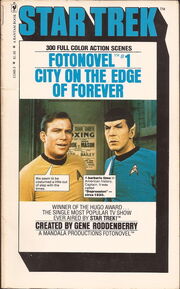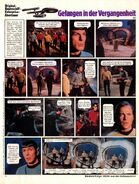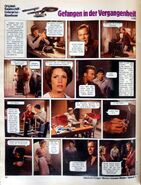(written from a Production point of view)

The very first book format Star Trek photonovel; City on the Edge of Forever (Nov. 1977)
Photonovels, occasionally spelled as Fotonovels, or referred to by the Italian-derived terms Fotoromanzo or Fumetti (the latter actually being the generic Italian word for comics, see: below), are print adaptations of television episodes or feature films into a book, using screenshots, or stills, with word bubbles instead of traditional text. While originally marketed as novels in the book format, most photonovels made today would be considered a form of graphic novel, a format closely linked to comics. A relatively short-lived phenomena at first, the book format of the genre came into vogue in the late 1970s and early 1980s, but went out of fashion just as quickly.
Due to the visual effects imagery involved, science fiction franchises of the period, like Alien, Buck Rogers in the 25th Century, Close Encounters of the Third Kind, Outland, Battlestar Galactica, and Star Trek were well represented while the format was popular. The German publisher Bastei for example, had in that era established a specialized collection, called "Filmromane", wherein such publications were incorporated, including its translated Star Trek titles. As far as that franchise was concerned, the contemporary publications of Bantam Books and Pocket Books have been particularly noteworthy for the original English-language publications. One of the pioneers of the book format, Richard J. Anobile, was commissioned by Pocket Books to create "Photostories" of the first two Star Trek films. Anobile incidentally, was also responsible for the adaptations of both Battlestar Galactica (1978, ISBN 0425041395) and Alien (1979, ISBN 0380466317) into photonovels, which were both released one year prior to the first Star Trek film title. [1] New outings in the format though, became nigh non-existent afterwards. The main reason for this was the widespread advent of the analog home video format – most conspicuously VHS – very shortly after its introduction, causing the perceived added value of the format to greatly diminish almost overnight.
Yet, from the mid-2010s onward The Walt Disney Company revived the format as the "Cinestory Comics", with photonovel-style reproductions of its popular animated films, as well as those for the Star Wars franchise that had already started the run under previous ownership with the 2008 release of Star Wars Episode IV: A New Hope (ISBN 9781593078744) – and which was actually one of the few contemporary science fiction properties not to see a photonovel adaptation back in the short-lived heyday of the book format. In December 2013, John Byrne has followed suit by reinvigorating the genre for Star Trek, when he wrote a "lost episode" photonovel comic published by IDW Publishing titled "Strange New Worlds". However, Byrne's concept involved taking digitally edited images from the original series and creating new narratives to simulate what a "lost episode" might have looked like with the original cast.
A major difference with the original format is that the latter-day iterations of the format are predominantly executed as graphic novel-sized trade paperbacks, whereas their 1970s/1980s predecessors were predominantly executed as the smaller-sized mass-market pocket book (Anobile's Alien was one of the rare exceptions), which included those for Star Trek.
English-language publications[]
- Bantam Books fotonovels (1977-1980)
- Pocket Books photostories (1980-1982)
- IDW Publishing photonovels (2013-)
- 1: Strange New Worlds
- 2: Star Trek: New Visions
- 3: The Mirror, Cracked
- 4: Time's Echo
- 5: Cry Vengeance
- 6: Made Out of Mudd
- 7: A Scent of Ghosts
- 8: Resistance
- 9: 1971/4860.2"
- 10": The Survival Equation
- 11: The Hollow Man
- 12: Mister Chekov
- 13: Of Woman Born
- 14: Swarm
- 15: The Hidden Face
- 16: Sam
- 17: The Traveler
- 18: Time Out of Joint
- 19: All the Ages Frozen
- 20: What Pain It Is to Drown
- 21: The Hunger
- 22: Isolation
- 23: The Enemy of My Enemy
- 24: An Unexpected Yesterday
German Star Trek photonovel magazine publications[]

First Star Trek cover Gong magazine, issue 3, January 1974
Though Richard Anobile has been recognized as a pioneer as far as the book format of the genre was concerned, he did not invent the photonovel genre proper, as it had been around since the late-1940s when it first appeared in Italy – hence the alternative "Fotoromanzi" and "Fumetti" designations for the genre. [2] Enjoying a certain measure of popularity, especially in the Romanic-speaking part of the world to this very day, as either short, or serialized stories in magazines – not all of them necessarily comics, or motion picture related – , they were until the late-1970s reinvention in the English-speaking world as book format novels considered an aberrant version of comics. [3]
Mentionable in regard to Star Trek are the 1973-1976 serialized photonovel stories as published in the weekly German television magazine Gong, which as far as Star Trek: The Original Series was concerned actually predated the Bantam releases by several years. [4] While very similar to the later Bantam releases, these photonovel versions were German originals, and at the time intended to run concurrent with the first time airing of The Original Series on West-German television. At that point in time though, public broadcaster ZDF only aired part of the series (roughly about half the total number of episodes, and not adhering to either the US broadcast or production order, instead randomly airing episodes taken from all three seasons), meaning that contemporary German fans became first acquainted with some episodes through the magazine publications only, the most conspicuous one having been "The City on the Edge of Forever", as that episode was not included in the original ZDF broadcast run. [5]
A remarkable feature of the German photonovel productions was, that the faces and character names of some guest stars were swapped out for the faces of replacement photonovel actors – an actual bonafide European occupation at the time – , presumably for copyright reasons. Original performers who were thus replaced by otherwise unknown actors included, Joan Collins (with her Edith Keeler becoming "Eva Light"), Jeffrey Hunter, Susan Oliver, Kim Darby and Michael J. Pollard. [6](X)
Known Gong publications included,
- 01: "Gefangen in der Vergangenheit" (issues 40, 1973 - 7, 1974, 20 pages; Bantam version, City on the Edge of Forever)
- 02: "Der Teufel im Dunkel" (issues 11 - 26, 1974, 16 pages; Bantam version, The Devil in the Dark)
- 03: "Die tödlichen Spiele" (1974)
- 04: "Der Planet der schrecklichen Kinder" (issues 8 - 27, 1974, 19 pages)
- 05: "Psycho Terror" (issues 8 - 24, 1975, 17 pages)
- 06: "Das große Verbrechen des Mr. Spock" (issues 26/1975 - 6/1976, 33 pages)
- 07: "Angst im Weltraum" (1976, 12 pages)
- 08: "Enterprise im Wunderland" (1976, 18 pages)
- 09: "Der unheimliche Herrscher" (1977, 15 pages)
- 10: "Die Menschenfabrik" (1977, 18 pages)
The editorial offices of Gong magazine resumed their photonovel editing efforts from 1980 to 1985 with their serialized magazine publications for the first three Star Trek films, to wit,
- 1: Star Trek - Der Film (issues 10 - 25, 1980, 32 pages; Pocket Books version, Star Trek: The Motion Picture - The Photostory)
- 2: Star Trek - Der Zorn des Khan (issues 49 - , 1983, 49 pages; Pocket Books version, Star Trek II: The Wrath of Khan Photostory)
- 3: Star Trek - Auf der Suche nach Mr. Spock (issues 46 - , 1985, 47 pages)
As with those of the 1973-1976 Original Series publications these concerned German originals and, contrary to Pocket Books' Wrath of Khan Photostory, all executed in full color, whereas the third film had not even seen a photonovel adaptation in the English-language territories, or any other language territory for that matter. [7]
Incidentally, Star Trek was not the only science fiction franchise that received the "Gong" photonovel treatment; the classic "Kampfstern Galactica" ("Battlestar Galactica") pilot film and television series were likewise serialized in the time period 1978-1981 as photonovels by the magazine – nor were they, as with those for Star Trek, in any way related to Anobile's abovementioned 1978 publication. [8] Similarly, but unlike in the English-speaking world at that point in time, Gong magazine also serialized the original "Der Krieg der Sterne" ("Star Wars")-film trilogy as photonovels in the same era for its German readership. [9]


